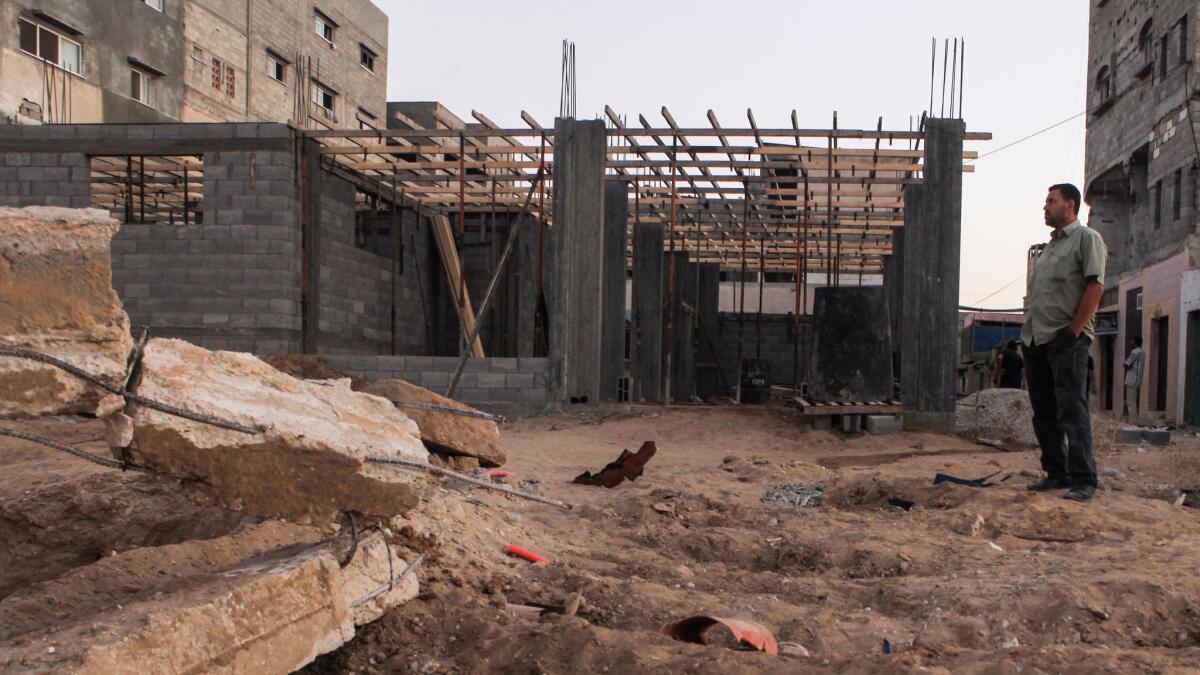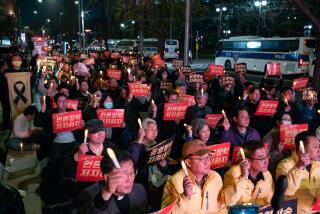Two years after war, rebuilding in Gaza is far from done, and international donors are bailing
Nashat Nawati jostled his way through a scrum of two dozen fellow Gazans outside of the Hamas housing ministry, hoping to get word about when he can expect to return home.
In the summer of 2014, the four-story building where Nawati lived with his extended family was reduced to rubble by Israeli bombs during a six-week war with Hamas. Two years later, Nawati and his six children are still stuck in temporary quarters half the size of his old apartment as they wait to get foreign aid necessary to rebuild.
“I lost my lovely big house in the last war,’’ said Nawati, 48, an unemployed government clerk with worn clothes and a look of anguish on his face. “Since then my family and I live in a small old rented flat that does not meet our basic needs.”
Nawati is one of about 75,000 Gazans still displaced from their homes as a $3.5-billion effort to rebuild Gaza from the destruction of the war creeps along at a pace officials say has fallen years behind schedule.
Israeli, Palestinian and international officials worry that the economic and humanitarian blight in the isolated coastal territory will ensure continued instability and that a new war may only be a matter of time. Last year, the United Nations warned that Gaza may become uninhabitable by 2020 if there is no change in the economic situation.
“Gaza’s reconstruction is going way too slow. Momentum has been lost and needs to be regained,’’ said Hans Jacob, Norway’s ambassador to the Palestinian territories at an April seminar on the effort. “The situation in Gaza is as catastrophic as ever.”

The rebuilding task is daunting. Gaza’s power lines and the territory’s sole power plant were hit during the war, leading to rolling power cuts of 12 to 18 hours a day on an electricity grid capable of supplying only half of the territory’s needs. The power shortage has hobbled Gaza’s sewage treatment plant, sending about 24 million gallons of raw sewage into the sea daily and creating a stifling stench along the coast. Schools, businesses, farms and medical centers also sustained tens of millions of dollars in damage.
There are multiple headwinds holding up the massive project: The Hamas-controlled territory of 1.8 million Palestinians is hemmed in by an Israeli and Egyptian blockade, and building materials like cement have been in short supply; a U.N.-run system that gives Israel oversight over the distribution of construction supplies has been criticized for slowing rebuilding with too much red tape.
The biggest problem, according to the United Nations, is funding shortfalls. Only about 50% of promised donor aid – about 1.4 billion -- was disbursed as of the end of March, according to the latest World Bank report. Among among large donors, the U.S. had transferred all of the $200 million it pledged, but Persian Gulf countries such as Kuwait, Qatar, the United Arab Emirates and Saudi Arabia had transferred only 15% or less of their pledges.
Nawati visits the Gaza housing ministry twice a month to check for any word of progress on the rebuilding of his home. The arrival of a new infusion of reconstruction aid from Kuwait in May briefly lifted his spirits, giving him hope that some of it would finally be earmarked for his building – but he left with a familiar answer.
“They said, ‘You’re not on the list,’” Nawati said. “‘There’s no estimate on when your house is going to be built.’”
From the housing ministry, Nawati took a reporter to his home in Shajaiya, a district on the eastern outskirts of Gaza City – a site of fierce fighting in 2014 because Hamas used buildings there to mask the openings of tunnels under the border with Israel less than a mile away. Swaths of homes were left in ruins.
Rubble from Nawati’s old home has long since been cleared away, like many places in Gaza that sustained damage. Now there’s just an empty lot with a small tent where residents and relatives from the neighborhood gather to sip tea with mint leaves.
“My kids used to play here with their friends. The mosque where I used to pray was on that corner,’’ he said. “Now my kids are dealing with the frustration of living far from their relatives and neighbors.”
Not far away, Nawati’s brother Nihad busied himself by working on a vegetable garden. The construction worker – who lived in the same apartment building as his brother -- complained that he had no work because of a shortage of building materials prompted by Israel’s six-week ban on cement in April.
“I’ve built most of the houses in this neighborhood but unfortunately today I am unable to do any renovation work,” said Nihad, 39.
The lack of building materials and restrictions on generators and heavy machinery are also hobbling the rebuilding. The Israeli human rights nonprofit Gisha said that from the end of the war through the end of 2015, only about 14% of the construction materials needed to rebuild Gaza made it through to the area.
Israeli officials say the restrictions are designed to prevent Hamas from rebuilding its military infrastructure in Gaza, especially the cross-border tunnels used to infiltrate southern Israel during the 2014 war. The director general of Israel’s foreign ministry in May accused Hamas of diverting 95% of cement shipments destined for rebuilding.
Israeli Prime Minister Benjamin Netanyahu has said it was in Israel’s interest to help solve Gaza’s water and electricity shortfalls because they create humanitarian problems that “don’t stop at the fences.”
Some progress has been made. Prefabricated mobile homes that were delivered to Gaza immediately after the war have since been removed after some residents were able to return home. Rubble cleared from buildings has been used to pave new roads, including a a new four-lane highway from Gaza City to Rafah.
“What has been built is only a drop in the ocean of destruction,’’ said Palestinian Housing Minister Mofeed Hasaina. According to the United Nations, it will take Gaza’s economy another two years to return to the point where it was before the war.
Unemployment among Gaza’s youth is estimated at 60%.
Gazans blame everyone for the bleak state of affairs: the Israeli military, which keeps the territory under a strict blockade; Arab governments, which have not sent pledged aid on time; and even their own leaders.
In private conversations in cafes and on social media, Gazans say they’re anxious that Hamas’ effort to rebuild its cross-border attack tunnels will one day bring new Israeli destruction to border areas like Shajaiya. They also gripe that the Gaza government has prioritized rebuilding homes of Hamas insiders and mosques.
“There’s great corruption in the reconstruction,’’ said Nawati. “Why is my house not there, I haven’t gotten a clear answer.”
Special correspondent Alouf reported from Gaza City and Mitnick from Tel Aviv and Ramallah.
Twitter: @joshmitnick
ALSO
Politics isn’t the only motive driving Palestinian knife attacks on Israeli soldiers
Meet the Saudi cleric who’s rallying Syrian rebels
Here’s why Netanyahu is apologizing to Israel’s Arab citizens
More to Read
Start your day right
Sign up for Essential California for news, features and recommendations from the L.A. Times and beyond in your inbox six days a week.
You may occasionally receive promotional content from the Los Angeles Times.






